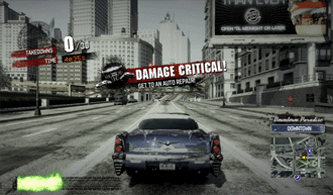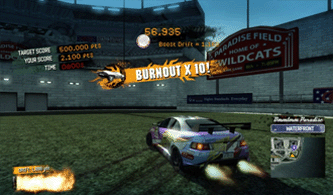I was once in a traffic accident, you know. A small fender bender, in which I slightly dented the back bumper of the white van driving in front of me during a hectic Belfast rush hour. The driver and his helper tried to sue me for a combined total of £32,000. Of course, they got nothing from me, given that a) I was fully insured and b) I’ve never even seen £32,000, let alone owned it. What’s my point? Well, if the driver of a Burnout Paradise car were involved in such a lawsuit, you’d be guaranteed to see more than three zeros on the end of the settlement check.
A lot more.
In a nutshell, Burnout Paradise is a game about driving very fast from Point A to Point B, smashing into whatever you feel like along the way. Other drivers are fair game to be shunted off the course and sent crashing into buildings, bridge supports, other cars, and even other drivers. What’s more, you’re rewarded for doing so. In what must be the AA’s worst nightmare, Burnout Paradise actively encourages players to be as vicious and aggressive in their driving as possible.
Of course, this is a Burnout tradition. As a series, it’s always been more arcade racer than simulation, with a strong emphasis on taking out the opposition in stylish ways rather than obsessively replaying tracks to strip another half-second off your lap time. Burnout Paradise is no exception, with every car available handling corners at high speeds easily and absorbing damage without undue effect (at least until the wheels start to fall off). Progression is also controlled by winning races, with new cars and access to more challenging races being handed out as rewards.
However, what is new is that Burnout Paradise has discarded the menu-heavy system of the previous titles completely. Instead, Criterion has delivered a free-form racing extravaganza, with players entirely free to race across the one (huge) city as they see fit, starting races by rolling up to junctions and spinning their wheels. This one change has altered the nature of the game considerably—gone are the easily repeated races, with the option to restart at any point. Now, players have to actively seek out races in-game, not in-menu, and races cannot be restarted without driving all the way back to the starting line. Also, races are no longer confined to set courses, with players entirely free to find their way from A to B without any guidance beyond a map, their own knowledge of the back streets, and a compass point.
Surprisingly, it works. The fact that races cannot be instantly restarted actually works in the game’s favor—gone is the temptation to repeat over and over until frustration sets in. Now, players have to accept their mistakes and race on regardless. Even completely failing an event doesn’t sting so badly, as Paradise City offers so much in the way of distraction that the player soon forgets their previous disappointment. There are literally races at every set of traffic lights, massive jumps at every turn and new shortcuts to find on every block. With so much to do, it really isn’t the end of the world when you can’t beat something the first time round.
And with that sense of sheer scale comes something else—a sense of freedom. Burnout Paradise is one of the most laid-back racing games I’ve ever encountered. Criterion left it entirely up to the players to decide how they want to play and progress. It’s the ultimate pick-up-and-play arcade racer—you can find just as much satisfaction racing along the city streets against up to 8 other AI-controlled cars as you can drifting around corners high in the mountains. Aside from the minor irritation of DJ Atomika, resident “DJ” and all-round idiot invention, there’ll be nothing to distract you from your free-form fun.
But if it is an organized race you want, Criterion hasn’t skimped on variety there, either. There are four basic race types. The first is a pure start-to-finish race, with you competing against other drivers to be the first to the post along Paradise’s busy streets. Marked Man events are similar to races, except that the other drivers are gunning just for you—the challenge is to make it to the finish without being totaled by the psychotic AI-controlled opponents. Stunt runs provide the opportunity to show off your skills and knowledge of the city, giving a limited amount of time for players to rack up points with impressive feats, chaining together spectacular stunts for combos. Finally, Road Rage events are pure havoc—take down as many other drivers as possible to beat the target without running out of time or totaling your car.
Aside from that, every road in the game is a self-contained race track. Drive from one end to the other while in “Show Time” mode to record your time, which is automatically entered into an online leaderboard. Each road can also be turned into a mini-destruction derby simply by holding down R1+L1 and crashing into on-coming traffic. Every car hit adds to your crash total, with buses giving score multipliers and major junctions providing maximum points. Achieve both the fastest time on a road and the highest crash score to “Own” it until someone faster comes along. Certainly, beating other people’s scores provides a considerable challenge, and given that every single road can be raced on and fought over, the scope of the game is considerable.
Getting online is easy and slick, with no lobbies to contend with. Merely request that the game place you online and it will seamlessly drop you into the company of up to seven other players, without long load times or even an apparent hitch in frame-rate. Voice communications are good, though not essential, and the game utilizes the PlayStation Eye attachment to great effect, sending photos from winners to losers and vice versa for maximum gloating rights. This gives the game an excellent personal touch, letting you get to know the people you’re actually racing against (and it can be turned off for you paranoid folks out there). Online games can be more than simple races, as well, with the option of attempting group challenges, such as jumping bridges in unison and getting to out-of-the-way spots for kicks.
Frankly, the game is beautiful. Running in HD, Burnout Paradise looks stunning, with the cars and the environments looking spectacular. The chrome effect in particular took my breath away, and the amount of detail is astounding. When your car crashes (and trust me, it will), Burnout Paradise shows it in glorious slow-motion, with every shard of shattered glass, fractured metal and fiery spark following the physics model perfectly. The frame-rate never dips, even when you’re traveling at extremely high speeds through heavy traffic, and the audio has to be heard to be believed. Every single one of the 75 unlockable cars sounds distinct and satisfyingly meaty, and the level of detail put into every one is unsurpassed.
There’s not much to criticize about Burnout Paradise. The loss of the always entertaining Crash mode from previous games, which saw players launching their cars into pre-scripted traffic junctions in order to achieve the highest number of cars crashed, will be mourned by every fan, but the scale of what remains softens the blow. To be honest, the only thing about the game that I could actually describe as a negative is the previously-mentioned infuriating DJ Atomika, whose dialogue is so completely cheesy, irrelevant and unnecessary, yet celebrated in-game as if he were something to be admired, that the average player’s brain becomes conditioned to filter him out (there’s a DJ Atomika podcast, constantly mentioned, for those of you not already sickened of him already).
With the obvious hints at downloadable content, the sheer scale of the races and the addictive, gratifying nature of the gameplay, Burnout Paradise is clearly a game to be reckoned with. Certainly, this reviewer will be playing it for many months to come. Frankly, I look forward to Burning with you.
Just don’t sue me, OK?



